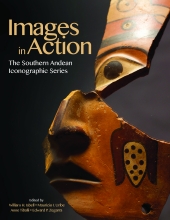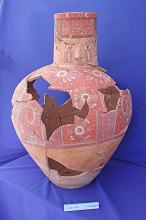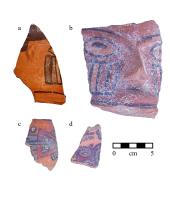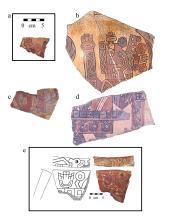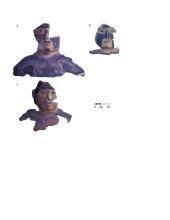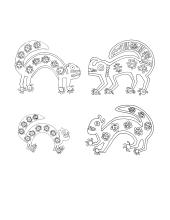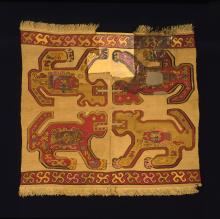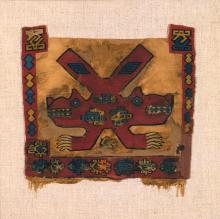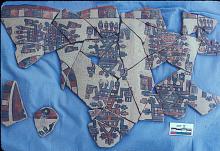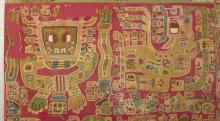Visual database
Chakipampa-style effigy jar from the 2000 Conchopata offering depicting Agent 102 with a chevron headband at the rim and pendent rectangle motifs on the cheek. Possible hand motifs are stylized as rectangles with five vertical bands and tips. Assigned to late Epoch 1B (AD 775-825). Courtesy of William H. Isbell.
Sherds from the 1977 Conchopata excavation units. (a) Ocros-style sherd from regular size Agent 102 jar from Unit A, Stratum 6; (b) Chakipampa-style sherd from oversize Agent 102 jar from Unit C, Stratum 4; (c) Ocros-style sherd depicting an incomplete "ventral animal" motif from Unit C, Stratum 4; (d) Chakipampa-style sherd depicting an incomplete "Ayacucho serpent" motif from Unit C, Stratum 4. Sherd "a" assigned to early Epoch 1B (AD 725-750). Sherds "b," "c," and "d" assigned to middle Epoch 1B (AD 750-775). Courtesy of Patricia J. Knobloch.
Ceramic sherds from Conchopata ceremonial vessels depicting incomplete SAIS Profile Deities in "a" and "b," Staff Gods in "c" and "d," and a bodiless, Profile Deity head in "e." Sherd "a" from 1977 Conchopata Unit C, Stratum 4. Sherds "b" and "c" from 2003 Conchopata deposit. Sherd "d" from Conchopata 1977 offering. Sherd "e" from 1977 Conchopata Unit A, wall trench. All sherds assigned to middle Epoch 1B (AD 750-775). Courtesy of Patricia J. Knobloch ("a," "e") and William H. Isbell ("b-d").
Examples of effigy jar fragments from 1977 Conchopata offering with incomplete depictions of individuals assigned to the Agent 102 category who wear the chevron headband. (a) Agent with elaborate cheek decoration, small moustache, and dotted beard; (b) agent with elaborate cheek decoration on a facial surface painted white; (c) agent with no facial decoration and a rather rounded facial appearance. The V-neck designs most likely represent the edges of actual tunics that displayed and initially spread the SAIS in Wari culture. Assigned to middle Epoch 1B (AD 750-775). Courtesy of William H. Isbell.
Variations in humped-animal motifs painted on the front, shoulder areas of the Agent 102 effigy jars from the 1977 Conchopata offering and most likely represent short tunics with tapestry representations. Assigned to middle Epoch 1B (AD 750-775). Courtesy of Patricia J. Knobloch.
A small tunic of interlocked tapestry weave with symmetrically arranged, confronting feline motifs. The length would allow the tunic to cover the wearer's shoulders and end just above the waist. Assigned to Epoch 1B (AD 725-825). Length = 84.5 cm, width = 87.5 cm. Courtesy of © Dumbarton Oaks, Pre-Columbian Collection, Washington, DC. B-511.
A tapestry fragment of interlocked weft and short slits about one-fourth the size of the small tunic in Figure 23.16 and therefore perhaps part of a small tunic as also implied by continued warp threads at bottom edge. Assigned to Epoch 1B (AD 725-825). Length = 31.5 cm, width = 30.5 cm. Courtesy of © Dumbarton Oaks, Pre-Columbian Collection, Washington, DC. B-512.
Body sherds from one Agent 102 effigy jar from the 1977 Conchopata offering depicting the less popular scenario of a dome-shaped motif surrounded by ventral animal icons. Assigned to middle Epoch 1B (AD 750-775). Courtesy of William H. Isbell.
A ventral animal icon next to a possible coastal rendition of Agent 102 as drawn from a coastal textile. Assigned to Epoch 1B (AD 725-825). Redrawn by P. J. Knobloch from a drawing by H. Ubbelohde-Doering (1926:Plates VI-VII). Courtesy of Patricia J. Knobloch.
Section of the Captives Tunic depicting the Captive Staff God, captive Agents 104 and 146, and winged Profile Deity on red background. Assigned to Epoch 2B (AD 850-900) in a derived Conchopata style. Private collection. Courtesy of Margaret Young-Sánchez. See Isbell and Knobloch (2009:Figure 4) for complete image of this tunic.
